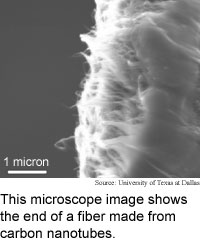
Practical nanotube fiber near
Spider silk, a product of 400 million years
of evolution, stops insects on the wing because it is five times tougher
than steel.
Scientists working with carbon nanotubes are looking to surpass
the strength of spider line. Nanotubes -- rolled-up sheets of carbon atoms
that occur naturally in soot -- also have useful electrical properties.
University of Texas at Dallas researchers have taken a step toward
making carbon nanotube fibers manufacturable by speeding up a nanotube fiber-making
method 100-fold to produce 70 centimeters of nanotube fiber per minute.
The researchers' 100-meter long fibers are four times tougher than
spider silk, and 17 times tougher than the Kevlar fiber used to make bulletproof
vests. Toughness is a measure of the energy needed to break a fiber.
The researchers made the fibers by mixing single-walled nanotubes
into a rotating solution of polyvinyl alcohol to produce gel fibers. They
also formed super capacitors, which store energy, by coating the fibers
with an electrolyte.
Antenna, batteries and electromagnetic shields could eventually
be made from the fibers, according to the researchers.
The fiber process could be used to manufacture small volumes within
a year, according to the researchers. The work appeared in the June 12,
2003 issue of Nature Materials.
Chip sorts colors
Software referees group calls
Prefab key to molecular memory
Wires make wireless strain gauge
News briefs:
See-through circuits closer
Protein traps nanoparticles
Nods drive audio interface
Nano rapid prototyping advances
Practical nanotube fiber near
Nanotube transistors make memory

Research Watch blog
View from the High Ground Q&A
How It Works
RSS Feeds:
News
Ad links:
Buy an ad link
Ad links: Clear History
Buy an ad link
|
TRN
Newswire and Headline Feeds for Web sites
|
© Copyright Technology Research News, LLC 2000-2010. All rights reserved.